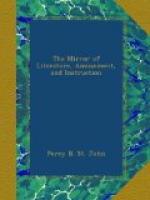Paper-making.—The manufacture of paper has of late rapidly increased in the United States. According to an estimate in 1829, the whole quantity made in this country amounted to about five to seven millions a year, and employed from ten to eleven thousand persons. Rags are not imported from Italy and Germany to the same amount as formerly, because people here save them more carefully; and the value of the rags, junk, etc., saved annually in the United States, is believed to amount to two millions of dollars. Machines for making paper of any length are much employed in the United States. The quality of American paper has also improved; but, as paper becomes much better by keeping, it is difficult to have it of the best quality in this country, the interest of capital being too high. The paper used here for printing compares very disadvantageously with that of England. Much wrapping paper is now made of straw, and paper for tracing through is prepared in Germany from the poplar tree. A letter of Mr. Brand, formerly a civil officer in Upper Provence, in France (which contains many pine forests), dated Feb. 12, 1830, has been published in the French papers, containing an account of his successful experiments to make coarse paper of the pine tree. The experiments of others have led to the same results. Any of our readers, interested in this subject, can find Mr. Brand’s letter in the Courrier Francais of Nov. 27, 1830, a French paper published in New York. In salt-works near Hull, Massachusetts, in which the sea-water is made to flow slowly over sheds of pine, in order to evaporate, the writer found large quantities of a white substance—the fibres of the pine wood dissolved and carried off by the brine—which seemed to require nothing but glue to convert it into paper.
* * * * *
THE NATURALIST
* * * * *
THE CUTTLE-FISH




